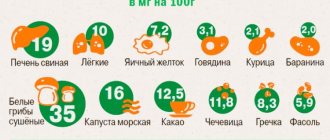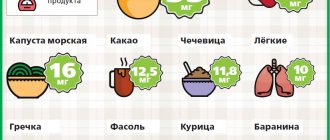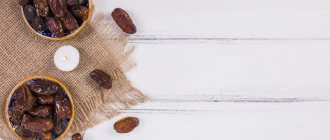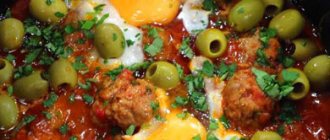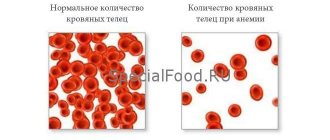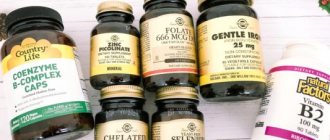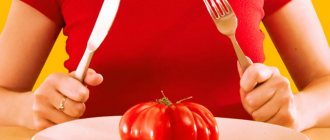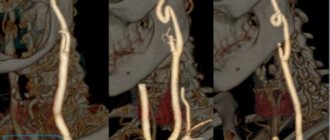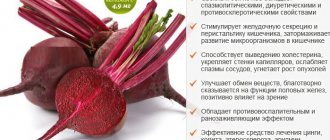Reduced hemoglobin comprehensively worsens the condition of the body, since in this case all organs and tissues experience oxygen starvation.
And this is complemented by an increased load on the cardiovascular system - the body simply accelerates blood flow to increase the flow of oxygen.
Hemoglobin deficiency and anemia are especially dangerous in preschool children - this often provokes the development of pathologies of the nervous system, which ultimately leads to mental retardation.
According to numerous studies , hemoglobin levels can be regulated by diet, including or excluding iron-containing foods from the diet.
We have compiled a rating of the 20 most effective foods that should be included in your diet to increase the concentration of hemoglobin in the blood. We will also describe general principles of nutrition and recommendations from doctors.
Let's remember that in the last article we looked at 7 products that reduce hemoglobin levels.
Factors influencing hemoglobin
The main hemoglobin is iron. It is through the process of its oxidation and reduction that oxygen is transported and absorbed in the tissues of a living organism.
Iron deficiency is one of the most common causes of a sharp decrease in hemoglobin levels.
However, simply including iron-rich foods in your diet is not enough. This microelement cannot be fully absorbed without certain factors. For example, to break it down into derivative atoms (which then react with certain groups of proteins), vitamin C, B vitamins (especially folic acid), omega-3 and omega-6 unsaturated fatty acids are needed.
At the same time, there are a number of factors that reduce the bioavailability of iron. For example, a high level of calcium in the body inhibits the production of new hemoglobin molecules. If there is a deficiency of the above microelements, iron simply will not be absorbed.
It is also worth considering that a decrease in hemoglobin levels can be provoked by a whole range of diseases of the cardiovascular system and gastrointestinal tract. That is why you should not delay going to the doctor - it is better to immediately establish the cause of hemoglobin deficiency and eliminate this particular factor.
If a low hemoglobin level is caused by a deficiency of micronutrients, then it is recommended to include the following foods in the diet:
- rich in iron;
- rich in vitamins C, E, B-group;
- rich in amino acids (preferably of animal origin);
- exclude those foods that reduce the bioavailability of iron.
In most cases, the above list of recommendations will be enough to normalize the composition of formed elements in the blood.
Iron deficiency - symptoms in women
We often attribute rapid fatigue, lack of vital energy, irritability, mood swings, frequent dizziness and an increased tendency to colds, restless legs syndrome to constant stress, heavy workload, weather conditions... There are many reasons for deterioration in well-being, isn’t it? ? But when external changes add to the collection of problems - the skin becomes dry, cracks appear in the corners of the mouth, nails change their shape (take on a concave appearance) and become fragile, and the hair becomes dull, often breaks and falls out more than usual, then the question arises: what is it about? What is the body trying to tell us? These manifestations can occur due to a lack of iron.
Interesting fact A woman can be “craving for salty foods” not only during pregnancy, but also, for example, due to iron deficiency. Its signs also include unusual changes in taste (the desire to “feast” on sand, chalk, clay, tooth powder, raw minced meat, etc.), and smell (the smells of gasoline, acetone, varnish, and paint seem attractive).
And iron deficiency in a child can manifest itself as a decrease in learning ability, increased fatigue, lethargy, tearfulness, and a tendency to frequent colds and intestinal infections. If you have the above symptoms, there is a reason to go for a check-up. However, it doesn’t hurt to get checked even in the absence of obvious symptoms of iron deficiency, in order to exclude its hidden deficiency.
List of 20 products to increase it
The body must receive all micronutrients in sufficient quantities, including minerals, vitamins, and metals. All these elements directly or indirectly affect the hematopoietic function, which needs to be stimulated (hemoglobin is produced in the bone marrow, like red blood cells, platelets, and leukocytes). So, here is a list of the 20 most effective products.
Liver
Any liver is useful for hemoglobin. Beef, chicken, pork will do. Moreover, it is particularly rare (rare), since in this case most of the micronutrients are preserved.
The liver contains B-group vitamins, iron (6.9 mg per 100 grams), and iodine - all this helps to increase hemoglobin levels.
Meat
The basis of any meat is a wide range of proteins and essential amino acids, which react with iron, thereby forming hemoglobin molecules.
More effective types of meat in this regard are rabbit, pork, and beef. But, again, the meat should be subjected to minimal heat treatment, ideally steamed.
Buckwheat
Almost all grains reduce the bioavailability of iron. The only exception is buckwheat, which acts exactly the opposite.
In addition, buckwheat also contains iron (almost 7 mg per 100 grams of kernels). That is why it is recommended to use it primarily as complementary food for infants, and not semolina (which contains calcium and, thereby, slows down the production of hemoglobin).
Halva
Halva contains a large amount of iron - almost 30 mg per 100 grams of product (and tahini contains even more - up to 50 mg per 100 grams). That is, 50 grams of such dessert provide the daily requirement of iron in the body.
But it’s worth considering that there are practically no B vitamins and ascorbic acid in halva. Therefore, if you include it in the diet, then take care of a sufficient standard of other micronutrients that promote the absorption of iron.
Beet
Contains iron, amino acids, and vitamins that help increase hemoglobin. The peculiarity of table beets is that all micronutrients are retained even during heat treatment.
You can also include beetroot juice in your diet, but you should drink it diluted (1 part juice to 2 parts water).
Pomegranate
Of all the fruits, pomegranate is considered the most beneficial for hemoglobin due to its high content of vitamin B6 .
There is also iron in pomegranate seeds, but in small quantities - only 1 - 1.5 milligrams per 100 grams.
Carrot
To raise hemoglobin, it is better to choose red carrots - they contain the most beta-carotene and vitamin A.
And these microelements help accelerate biochemical reactions using calcium - reducing its “free” level in the blood increases the bioavailability of iron (carrots contain only 0.5 - 0.7 mg per 100 grams).
Dried fruits
The best dried fruits to eat are prunes, raisins, apricots, cherries, cherries, bananas - they contain B vitamins, E, C.
The fact that dried fruits contain a large amount of plant fiber also helps speed up the absorption of iron - this comprehensively normalizes the functioning of the gastrointestinal tract.
Nuts
Walnuts, as well as pistachios, contain a considerable amount of omega-3 and omega-6 unsaturated fatty acids, which accelerate a whole complex of intercellular metabolic processes, including those with iron.
Nuts are considered the most beneficial for young children - they reduce the likelihood of developing pathologies of the nervous system by almost 2 times.
But you should avoid peanuts. It is extremely high in fat, which creates a high load on the gastrointestinal tract and also slows down the absorption of iron.
See 7 nuts that are good for your blood in a separate article.
Fish roe
Both red, black, and yellow caviar are very useful in this regard, as they contain iron (from 6 to 12 mg per 100 grams), as well as omega-3 unsaturated fatty acids. Literally 100 grams of this product per day completely provides the body with all the necessary micronutrients to normalize hemoglobin levels.
And most importantly, this product is easily digestible, so it can be included in the diet if you have chronic diseases of the gastrointestinal tract (when meat or liver are contraindicated).
Honey
The main benefit of honey is that it contains a huge range of minerals (including rare ones that cannot be obtained from other foods), which has a positive effect on the water-salt balance . And this is also an important point in normalizing hemoglobin levels.
This will also help get rid of edema, which often occurs when the load on the cardiovascular system increases (which will certainly happen with a hemoglobin deficiency).
Nutritionists indicate that you need to eat buckwheat or honeydew honey to achieve the desired effect - they have the highest concentration of minerals.
Nettle
Contains a small amount of iron, as well as vitamin B12, which increases its bioavailability for the body .
Doctors recommend including nettle in the diet as a spice (dried) during pregnancy and breastfeeding.
But it is worth remembering that it also stimulates the secretion of gastric juice, which in case of gastritis or peptic ulcer of the stomach and/or duodenum can aggravate the patient’s condition.
Eggs
To increase hemoglobin, you should consume egg yolks - they contain up to 8 mg per 100 grams of iron. And it is better to eat them fresh or soft-boiled.
Fresh chicken eggs can be a source of salmonellosis. But quails also contain iron, but their shells have smaller pores through which infection does not penetrate. Therefore, they are considered safer and are recommended for children to include in their diet.
Fish
Sea fish is rich in omega-3 unsaturated fatty acids. And the fattier it is, the more fatty acids it contains. River fishing is also useful in this regard; carp (mirror), pike and perch are better suited. And among the marine varieties of fish - tuna and salmon.
By the way, eating seaweed is no less useful. It contains iodine, which normalizes the functioning of the endocrine system (which indirectly regulates the production of hemoglobin).
Chocolate
Cocoa powder contains up to 12 mg of iron per 100 grams (depending on the variety and variety). Nutritionists say that you should eat natural dark chocolate. Less useful are milky, white, pink.
And it is advisable to prepare chocolate yourself at home without adding butter (as it reduces the bioavailability of iron).
Chocolate also stimulates metabolic processes between cells by stimulating the production of endorphins. But you should not abuse this property, since the body tends to increase the need for the same serotonin. That is, over time, addiction and a kind of dependence develop.
Rose hip
Among berries, rose hips are the largest source of ascorbic acid, which is used in biochemical processes involving iron.
It is better to consume rose hips in the form of a decoction (50 grams of fresh or dried berries per 300 milliliters of boiling water) or jelly.
Although rose hips contain a large amount of vitamin C, it does not irritate the mucous membrane of the stomach and esophagus, so these berries can be included in the diet for chronic diseases of the gastrointestinal tract.
Currant
Contains slightly less ascorbic acid than rose hips. It is better to use black currants - they contain less tannin than red ones (tannin is a tannin and slows down the production of hemoglobin).
No less useful are currant leaves, from which you can prepare aromatic and tasty tea. Its use is also an excellent prevention of immunodeficiency.
Strawberry
Strawberries are rich in vitamin C and also contain a small amount of iron (from 0.2 to 1 mg per 100 grams, depending on the variety and growing method).
Just eat whole strawberries either with sugar or honey, but not with sour cream, yogurt or cream.
Turmeric
Of the spices, turmeric contains the most iron - about 35-50 mg per 100 grams. And most importantly, it is great for preparing almost any dish, even some desserts.
During pregnancy, turmeric should not be abused, as it can provoke smooth muscle spasms. In critical cases, this will even lead to premature birth. Doctors in most cases warn about this.
Parsley
Of the iron-containing greens, parsley is the healthiest. But it should be consumed fresh, so it is better to add it to salads rather than to soups. Contains about 2 mg of iron per 100 grams.
Parsley root is no less useful. It is also used as a spice.
Also check out the product table:
How is the effectiveness of treatment assessed?
During the first days of treatment with iron supplements, physical sensations are assessed.
When treating anemia, on the 5-8th day of treatment, a reticulocyte crisis is determined (an increase in the number of reticulocytes compared to the initial value, usually by 2-3% or 20-30‰).
After 4 weeks of treatment, the increase in hemoglobin is assessed. An increase in hemoglobin concentration by 10 g/l by the end of the first month of treatment with iron preparations indicates that the dose has been correctly selected and the effectiveness of therapy. After hemoglobin is restored, therapy is continued to saturate the iron depot, while the dose of the drug is reduced by 2 times.
For hidden iron deficiency, half doses of the drugs are used for 4-8 weeks. Depot saturation is determined using a comprehensive biochemical study (ferritin, transferrin, TLC).
At Lab4U you can take tests to identify iron deficiency and monitor the effectiveness of therapy with a discount of up to 50%.
General nutrition rules
To raise hemoglobin more quickly and effectively, nutritionists recommend following the following tips:
- Keep small meals. You need to eat in small portions, but as often as possible. Optimally – at least 6 times a day.
- Avoid cereals (except buckwheat) and fermented milk products - they all slow down the absorption of iron and interfere with the production of formed elements and hemoglobin.
- Walk in the fresh air as often as possible - a sufficient balance of oxygen in the blood also indirectly stimulates the renewal of hemoglobin molecules and prevents the oxidation and destruction of red blood cells. Ideally, take walks in the fresh air after each meal (this will also help significantly speed up your metabolism).
- Avoid tea and coffee. It is better to give preference to herbal teas, as well as homemade compotes, fruit and vegetable juices.
- Do not eat 2-3 hours before your planned bedtime. Metabolic processes during sleep slow down significantly, so iron and vitamins are practically not absorbed during this period (but the load on the gastric mucosa increases, since the utilization of gastric juice slows down).
Fully or partially limited products
Excluded from the diet are very fatty meats, fish and poultry, culinary, beef and lamb fat, spices, fatty and very hot sauces, pastries and cakes with a large content of cream.
Limit foods high in calcium (milk and dairy products, parsley), tannin and caffeine (coffee, strong tea, chocolate, Coca-Cola), as they interfere with the absorption of iron.
Drinking alcohol in case of iron deficiency anemia is completely excluded, since ethyl alcohol negatively affects the liver and disrupts the absorption of iron and flavocins .
Table of prohibited products
| Proteins, g | Fats, g | Carbohydrates, g | Calories, kcal | |
| cake | 3,8 | 22,6 | 47,0 | 397 |
| chocolate | 5,4 | 35,3 | 56,5 | 544 |
| mayonnaise | 2,4 | 67,0 | 3,9 | 627 |
| sour cream 30% | 2,4 | 30,0 | 3,1 | 294 |
| pork fat | 1,4 | 92,8 | 0,0 | 841 |
| rendered beef fat | 0,0 | 99,7 | 0,0 | 897 |
| cooking fat | 0,0 | 99,7 | 0,0 | 897 |
| rendered pork fat | 0,0 | 99,6 | 0,0 | 896 |
| white dessert wine 16% | 0,5 | 0,0 | 16,0 | 153 |
| dry red wine | 0,2 | 0,0 | 0,3 | 68 |
| vodka | 0,0 | 0,0 | 0,1 | 235 |
| cognac | 0,0 | 0,0 | 0,1 | 239 |
| liquor | 0,3 | 1,1 | 17,2 | 242 |
| beer | 0,3 | 0,0 | 4,6 | 42 |
| cola | 0,0 | 0,0 | 10,4 | 42 |
| coffee | 0,2 | 0,0 | 0,3 | 2 |
| Pepsi | 0,0 | 0,0 | 8,7 | 38 |
| black tea | 20,0 | 5,1 | 6,9 | 152 |
| energy drink | 0,0 | 0,0 | 11,3 | 45 |
| * data is per 100 g of product | ||||
Features of the diet for certain groups of patients
The nutritional rules for low hemoglobin are somewhat different for different groups of patients. Nutritionists indicate:
- Adults. The iron requirement for adults is about 12 mg per day. It is much easier for adults to digest meat products and animal by-products (liver, lungs, kidneys, heart). It is recommended to include them in the diet daily, at least in minimal quantities.
- Children. The iron requirement for children is from 8 to 11 milligrams per day. Preference should be given to plant products. But you should not overuse milk, especially fatty milk, as it radically reduces the level of hemoglobin and slows down the absorption of iron. It is also recommended to include buckwheat, fish, a small amount of chocolate and halva in the diet.
- Pregnant women. The iron requirement in pregnant women is the highest and reaches 20 mg per day. As a rule, to normalize hemoglobin, they are prescribed specialized vitamin complexes. It is also recommended to eat fish, red caviar, and carrots. But it is better to avoid turmeric, parsley and most other spices that stimulate smooth muscle spasms. The doctor with whom the woman registers must talk about all this in detail.
- Elderly. Their need for iron is the smallest - only 6 - 8 mg per day, which is explained by the natural slowdown in the functionality of the cardiovascular system and bone marrow. Doctors also recommend that older people consume fish, chicken fillet (breast, since there is practically no fat in it), as well as pomegranate and beet juice.
Folk remedies and vitamin complexes
If the inclusion of the above products in the diet does not bring the desired effect, then you can use folk remedies to increase hemoglobin levels. Many of them are extremely effective and are recommended for use even by doctors. The most popular of these methods:
- Dandelion root decoction. Helps normalize the biochemical composition of the blood and accelerate the removal of toxins. To prepare, mix 30 grams of grated fresh dandelion roots with 2 cups of boiling water. Leave for at least 2 hours (until completely cooled). Take 1 teaspoon, diluting it in a glass of water with honey. Take 2 times a day.
- Infusion of rosehip and honey. To prepare, mix 10 grams of dry grated rose hips, 2 tablespoons of honey and a glass of boiling water. Infuse for 30-40 minutes, take as tea 2 times a day. The course is no more than 2 weeks (if longer, there may be excess iron in the body, which also negatively affects health).
- Infusion of St. John's wort, blackberry leaves and chamomile. Mix 1 teaspoon of dry herbal base, add 300 milliliters of water and leave for 2 hours. Take 50 milliliters 3 times a day until hemoglobin levels normalize (but not more than 4 weeks).
If traditional methods of treatment do not bring the desired effect, then drug therapy is prescribed. As a rule, these are multivitamin complexes with a high content of iron, B vitamins, and ascorbic acid. But calcium in such preparations is either completely absent or contained in very small quantities. Popular vitamin complexes of this group:
- Decamevit;
- Aevit;
- Complivit;
- Doppel-Hertz (with iron).
Just check with your doctor for the recommended dosage, as well as the duration of the course of treatment.
How to increase the effectiveness of treatment
To reduce the likelihood of side effects, iron salts are taken before meals.
The absorption of iron is higher when taken simultaneously with ascorbic and succinic acids, fructose, and cysteine. This property is used in some combination drugs.
Iron absorption is reduced by certain substances from food or medications. Thus, it is reduced by tannin (strongly brewed tea), calcium salts (in milk or medications), magnesium and manganese (in mineral complexes or antacid preparations, such as phosphalugel), tetracycline antibiotics, phosphoric and phytic acids (cereal seeds, legumes). This effect is smoothed out when using preparations based on ferric iron.
Iron absorption is increased in severe iron deficiency. Therefore, you should be more careful about the prescribed dosage. Doctors often rely on a therapeutic dose of 200 mg of iron ion/day. If you understand that an iron supplement is not suitable for you due to the development of adverse reactions, difficulties in taking it, or lack of improvement in your well-being, tell your doctor about this. Under no circumstances should you change the dosage of the drug yourself. Exceeding the dose can lead to overdose and poisoning, reducing the dose can lead to useless use and lack of effect.
